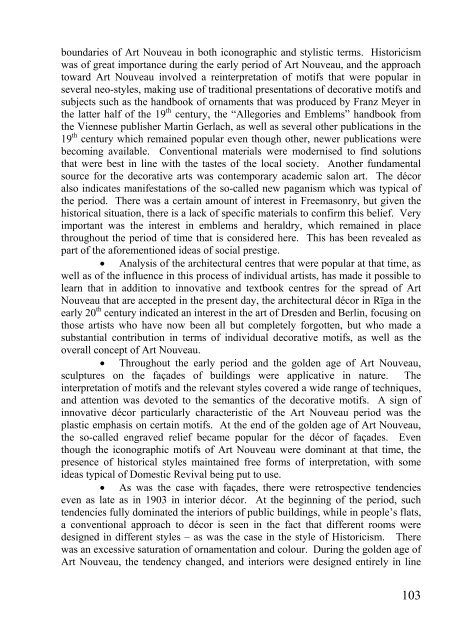SILVIJA GROSA JŪGENDSTILA PERIODA PLASTISKAIS UN ...
SILVIJA GROSA JŪGENDSTILA PERIODA PLASTISKAIS UN ...
SILVIJA GROSA JŪGENDSTILA PERIODA PLASTISKAIS UN ...
You also want an ePaper? Increase the reach of your titles
YUMPU automatically turns print PDFs into web optimized ePapers that Google loves.
oundaries of Art Nouveau in both iconographic and stylistic terms. Historicism<br />
was of great importance during the early period of Art Nouveau, and the approach<br />
toward Art Nouveau involved a reinterpretation of motifs that were popular in<br />
several neo-styles, making use of traditional presentations of decorative motifs and<br />
subjects such as the handbook of ornaments that was produced by Franz Meyer in<br />
the latter half of the 19 th century, the “Allegories and Emblems” handbook from<br />
the Viennese publisher Martin Gerlach, as well as several other publications in the<br />
19 th century which remained popular even though other, newer publications were<br />
becoming available. Conventional materials were modernised to find solutions<br />
that were best in line with the tastes of the local society. Another fundamental<br />
source for the decorative arts was contemporary academic salon art. The décor<br />
also indicates manifestations of the so-called new paganism which was typical of<br />
the period. There was a certain amount of interest in Freemasonry, but given the<br />
historical situation, there is a lack of specific materials to confirm this belief. Very<br />
important was the interest in emblems and heraldry, which remained in place<br />
throughout the period of time that is considered here. This has been revealed as<br />
part of the aforementioned ideas of social prestige.<br />
• Analysis of the architectural centres that were popular at that time, as<br />
well as of the influence in this process of individual artists, has made it possible to<br />
learn that in addition to innovative and textbook centres for the spread of Art<br />
Nouveau that are accepted in the present day, the architectural décor in Rīga in the<br />
early 20 th century indicated an interest in the art of Dresden and Berlin, focusing on<br />
those artists who have now been all but completely forgotten, but who made a<br />
substantial contribution in terms of individual decorative motifs, as well as the<br />
overall concept of Art Nouveau.<br />
• Throughout the early period and the golden age of Art Nouveau,<br />
sculptures on the façades of buildings were applicative in nature. The<br />
interpretation of motifs and the relevant styles covered a wide range of techniques,<br />
and attention was devoted to the semantics of the decorative motifs. A sign of<br />
innovative décor particularly characteristic of the Art Nouveau period was the<br />
plastic emphasis on certain motifs. At the end of the golden age of Art Nouveau,<br />
the so-called engraved relief became popular for the décor of façades. Even<br />
though the iconographic motifs of Art Nouveau were dominant at that time, the<br />
presence of historical styles maintained free forms of interpretation, with some<br />
ideas typical of Domestic Revival being put to use.<br />
• As was the case with façades, there were retrospective tendencies<br />
even as late as in 1903 in interior décor. At the beginning of the period, such<br />
tendencies fully dominated the interiors of public buildings, while in people’s flats,<br />
a conventional approach to décor is seen in the fact that different rooms were<br />
designed in different styles – as was the case in the style of Historicism. There<br />
was an excessive saturation of ornamentation and colour. During the golden age of<br />
Art Nouveau, the tendency changed, and interiors were designed entirely in line<br />
103












